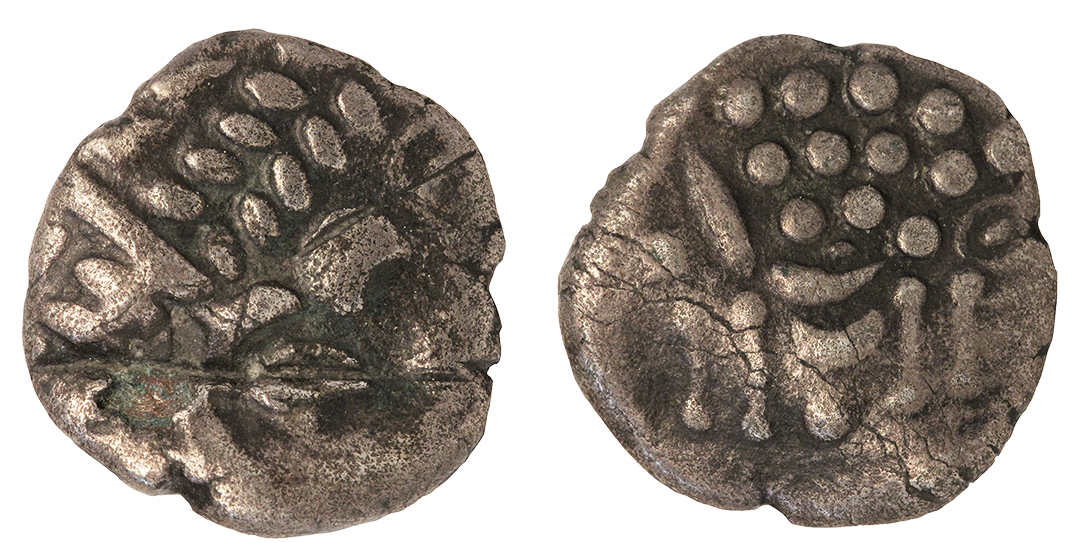
Numismatic Articles
Van Arsdell 2019b (Info)
Semiotics of Celtic Coins XV – People Breaking Things
By Robert D. Van Arsdell
Ritually-killed coins?
The damaged coin at the top of this article appeared in May 1987. It was described as one of many such coins found in a hoard of Durotrigan silver staters. There was no other information available and although Badbury-Shapwick is an attractive suggestion, the likely hoard was never identified. At the time, I merely assumed this was an example of a "ritually-killed" coin and thought little more of it.
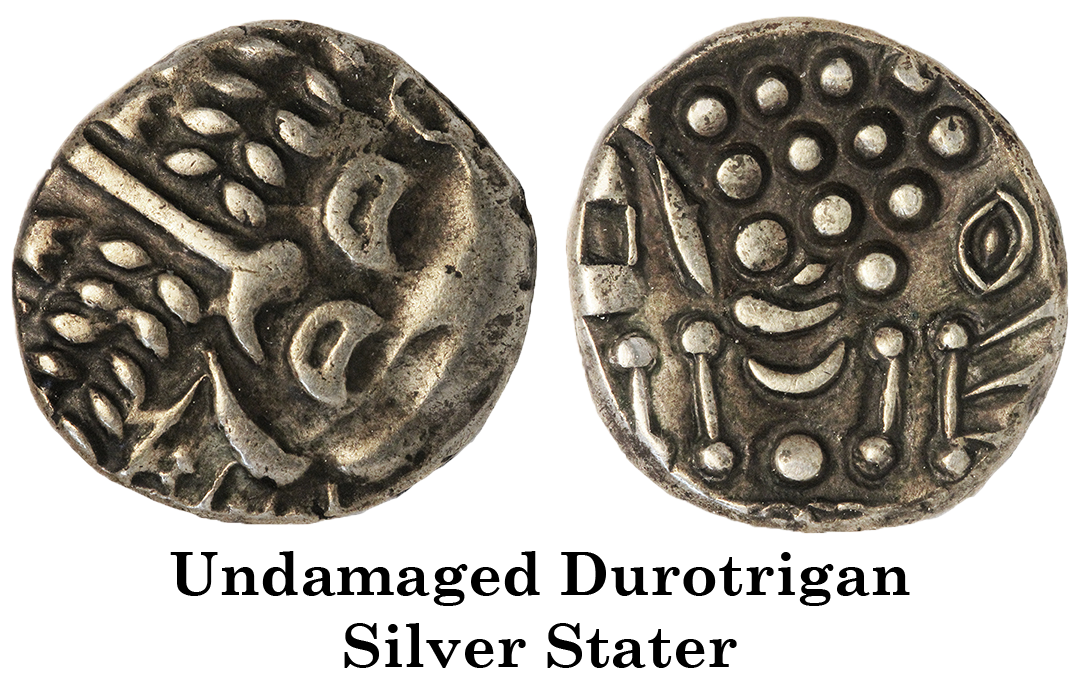
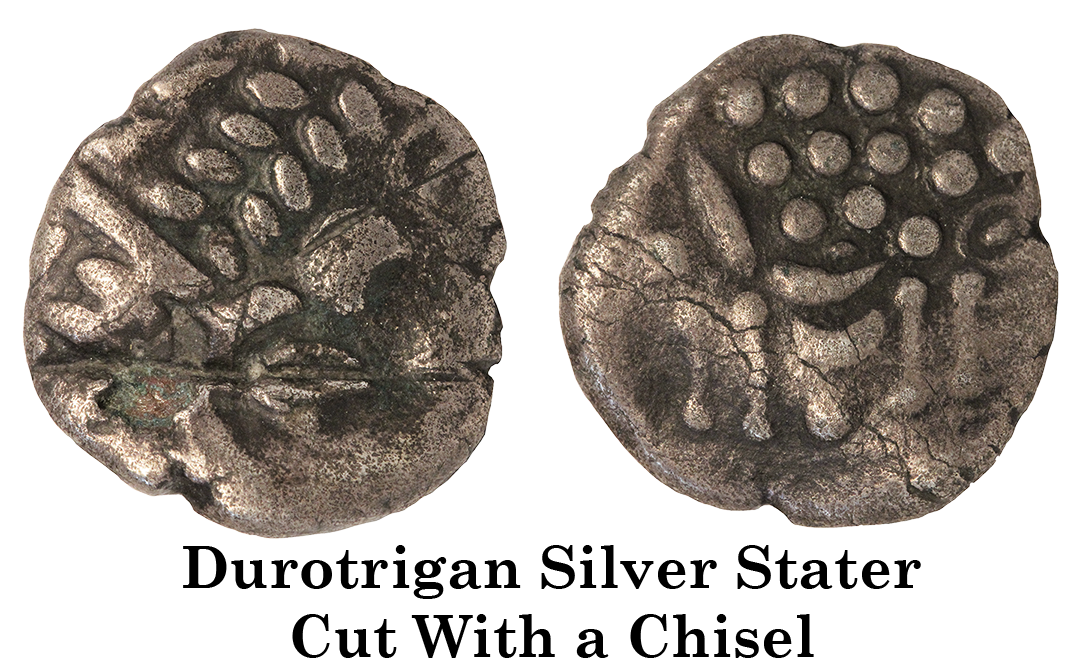
Philip de Jersey's 2005 paper on defaced coins recorded two other Durotrigan hoards with damaged coins: Upton (Nursling) 1995 and a second hoard also thought to have been found at Nursling in 1997. In 2014, he sensibly suggested that the 1995 parcel was a scatter of coins disturbed by plowing and the 1997 parcel was the undisturbed portion buried below plow-level.(Info) It now appears that another hoard with defaced coins may have been found eight years before the Upton hoards. The passage of time makes it unlikely we will ever be able to identify more of the coins, or establish that a hoard was indeed found.
The term "ritually-killed" is laden with emotional connotations such as "savage religious rites" and "violence". It should be dropped if we are to appraise the coins in a sensible manner. The fact that the term is so attractive is worth scrutiny. Where did it come from? More to the point, what does it tell us about human behavior? Were people trying to "send a message" – is something semiotic going on?
Swords to Coins
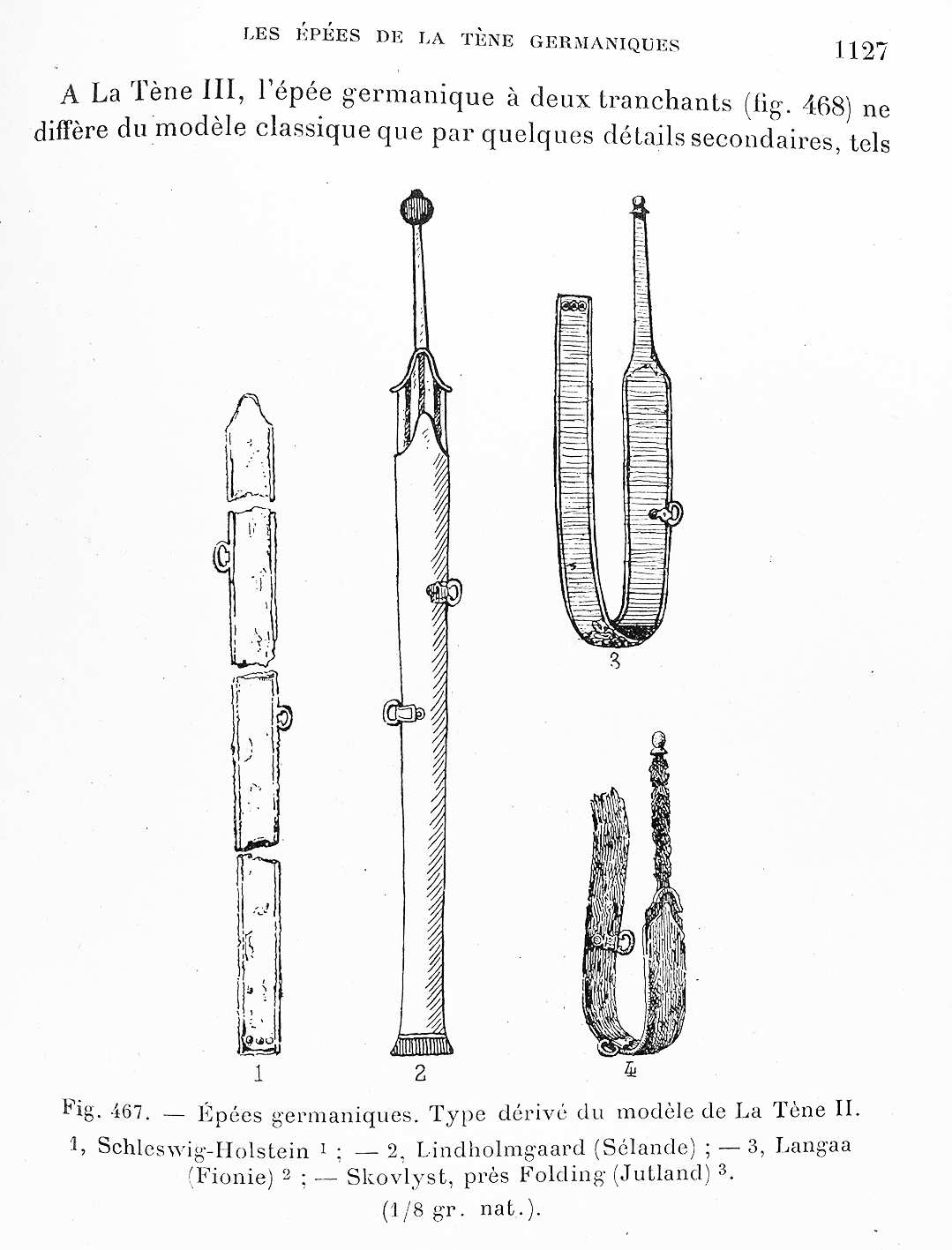
The term originally had nothing to do with coins. A French archaeologist, Salomon Reinach, first suggested it should be used to describe swords that had been bent or broken before they were buried.(Info)
The idea quickly caught on, and by 1914, Déchelette was citing Reinach in his Manual D'Archéologie. Over the years, other ritually-killed swords were identified,(Info) but only in Eastern Europe were large numbers found.(Info) Perhaps more conservatively, Pleiner has suggested that we have scant evidence for any sort of ritual and that the term should be dropped.(Info)
It's difficult to identify the first use of "ritual killing" in relation to coins, but a hoard found in 1897 at Marburg, Germany has been interpreted in the 1980s using the term "rituellem Einhieb".(Info)
Identifying ritual behavior
When are we seeing human behavior that reveals some kind of ritual? Smashing coins could be nothing more than one person destroying things out of frustration.
Barry Cunliffe gives us a set of useful guidelines for identifying ritual behavior. (Info)Although Cunliffe's thinking was applied to special deposits found in Iron Age storage pits, the concepts can be adapted to numismatics. It should be emphasized that his treatment of pit deposits is not only detailed and nuanced, it's backed up with statistical analyses. Numismatists don't have the masses of data to undertake such an analysis. Yet, the concepts can help us identify situations where rituals might be lurking in the shadows. The list that follows should be considered a simplification of a complex subject.
Some criteria to help us identify ritual behavior:
- Some evidence that a belief system is involved
- The behavior is seen over a wide enough region and time to be seen as recurring and involving large numbers of people
- The behavior involves different kinds of objects and has variations in practice (eg: burying some objects in the ground and throwing others in rivers and lakes)
- Depositing hoards of objects with no intention of recovering them
- The behavior begins and ends abruptly, suggesting the emergence and discard of a belief system
It should be noted that rituals involving a belief system do not necessarily demand a religious belief system. Rituals celebrating past glories or esteemed leaders could do nicely, yet be secular celebrations.
Do Durotrigan coins meet Cunliffe's criteria?
Cunliffe's propitiation-and-pits ritual was supported by an enormous number of examples spread over many sites. Nothing of the sort supports the idea of ritually-killed Durotrigan coins. We have at best three instances of hoards reported. (Info)Nor could we begin to assert that we understand an underlying belief system. Calling the coins "ritually-killed" is an unsubstantiated speculation.
De Jersey came to essentially the same conclusion in his 2005 article. He noted the Upton coins were damaged in a very specific way, suggesting the person involved was doing the damage repeatably. He also noted a possible belief system that could support the idea of ritual behavior. Yet, in the final analysis, he rejected the idea because of the small number of instances known.
Nonetheless, we evidently are seeing the repeated act of a small number of people in a restricted locale. Consequently, although we shouldn't call the damage "ritual", we might suspect something semiotic is going on. A small number of people might have been trying to send a message. We could try a semiotic analysis and see if anything plausible is in the offing.
The semiotics
The first step is to determine the way the sign was produced using Eco's Theory of Sign Production. (Info)
The person damaging the coins may have done so as a reaction to seeing the coin or its imagery and deciding to take some action. It's unlikely the person smashed the coins and then decided what it meant. Thus Moderate, not Radical Invention is the likely mode of production. The fact that multiple coins were damaged in a repetitive way further suggests that the decision to damage the coins was thought out to some extent.
Moderate invention lets us separate the non-semiotic aspects (Stimuli and Content Nebula) from the semiotics (Transformation, code-making, Expression Cluster and imagery). (Info)We'll start by analyzing the Transformation and the resulting Expression Cluster.(Info)
The Expression Cluster (in this case of vandalism) is the original Durotrigan silver stater and the chisel cuts. We needn't go into the intended message from the Durotrigan ruler at this point. The vandal's First Denotation would probably be something like opposition, hatred, rejection or anguish. It's unlikely the vandal was happy about everything but decided to smash the coin anyway.
The First Connotations are more difficult to fathom. Some possible ones include:
- The vandal doesn't like the issuing authority (the Durotrigan nobility)
- The vandal doesn't like the ruler who issued the coin
- The vandal doesn't like the images on the coin
- The vandal doesn't like the meaning of the images on the coin
- The vandal doesn't like the Durotrigan people
- The vandal has had an argument with a Durotrigan person and is miffed
- The vandal doesn't like the political situation
- The vandal feels cheated
- The vandal doesn't like money
- The vandal is trying to mark the coins as "my property"
- The vandal doesn't like any multitude of things
It would be very hard to decide which, if any of these connotations is correct. Perhaps looking at the Stimuli and Content Nebula could help identify which ones prompted the vandal to act. Silver staters date from the Gallic War onward, the damage to the coin was probably inflicted later in the War, or afterwards. We might anticipate that the War and its aftermath looms large amongst the Stimuli.
Some possible Stimuli:
- Before the Gallic War, coins of the Durotriges and Atrebates are found in each other's territory
- Before the War, trade probably existed between the two tribal groups
- Sometime after the War, exchange appears to subside and coins stop crossing the border
- The Caesarean Invasions may have altered the relationship of the tribes and their alliances with groups on the Continent
- Durotrigan coins become very debased after the War
- Coins struck by other tribes do not become debased to such a degree
- Unsettled conditions may prompt people to hide their wealth
- Agency considerations
The term "agency" needs explanation. It comes from Anthropology and means the ability of people to make their own choices and act independently – to do things. Agency is also attributed to inamimate objects.
The notion that inanimate objects can have "agency" is perhaps a strange one. The usual example given is the warrior and the sword. It's obvious the warrior is the one acting; the sword would just lie there if the warrior didn't pick it up. However, in most people's mind the sword is seen as inflicting damage and capable of violence, although, strictly speaking, it does no such thing of its own accord. Yet, the sword and warrior become one during the course of battle. Thus people come to believe believe the sword, in some way, has received and possesses the agency of the warrior. (Info)
The First Connotation that the vandal doesn't like money involves the concept of agency. It's the idea embedded in "money is the root of all evil". If one accepts that inanimate objects can have agency, then one could anticipate that money is one of the most agency-endowed objects. Hence people can hate money because they dislike the agency it possesses. (Info)
The Content Nebulae
Looking at the Stimuli, we could contruct several scenarios that produce plausible Content Nebulae, for example:
- A scenario in which someone outside Durotrigan territory has amassed a large number of Durotrigan coins, and finds them worthless in exchange after the Gallic War. The holder may feel cheated because of the political siutuation, and decides to express that anger by smashing the coins.
- A situation in which someone has coins that have lost value because of the debasement of the Durotrigan coinage after the War. The holder may be expressing anger towards the Durotrigan rulers responsible.
- The scenario where someone is hiding wealth in the ground and wants to be able to identify the coins in the event someone else digs them up.
The Transformations
In these cases, the Transformations would be to mark the coins to express some emotion. The First Connotations would, respectively be:
- Anger about the political situation that resulted in reduced trade between the Durotriges and Atrebates
- Anger about the Durotrigan nobility
- Anguish about the possibility that thieves will steal the coins
It should be immediately obvious that although each of these Transformations may be plausible, none of them is particularly convincing – much less compelling. We're at a loss to rank them for plausibility or to assert any of them is best. The problem is the list of Stimuli is woefully inadequate, and we fear the Content Nebulae are suspect as a result. The solution would be to add to the Stimuli and further analyze the Content Nebulae. For example, if one of the Stimuli was the revelation that the vandal had been the recipient of great wealth during the War, then the First Connotation "the vandal hates money" would be less likely.
Overall, one gets the feeling further effort would be a fruitless. We're unlikely to understand the Stimuli and Content Nebulae to a sufficient degree to make much headway. At best, we can say two things:
- These probably wasn't any sort of ritual activity involved in the damage
- There probably was something semiotic intended by the individual damaging the coin
A modern example illustrates the problem further
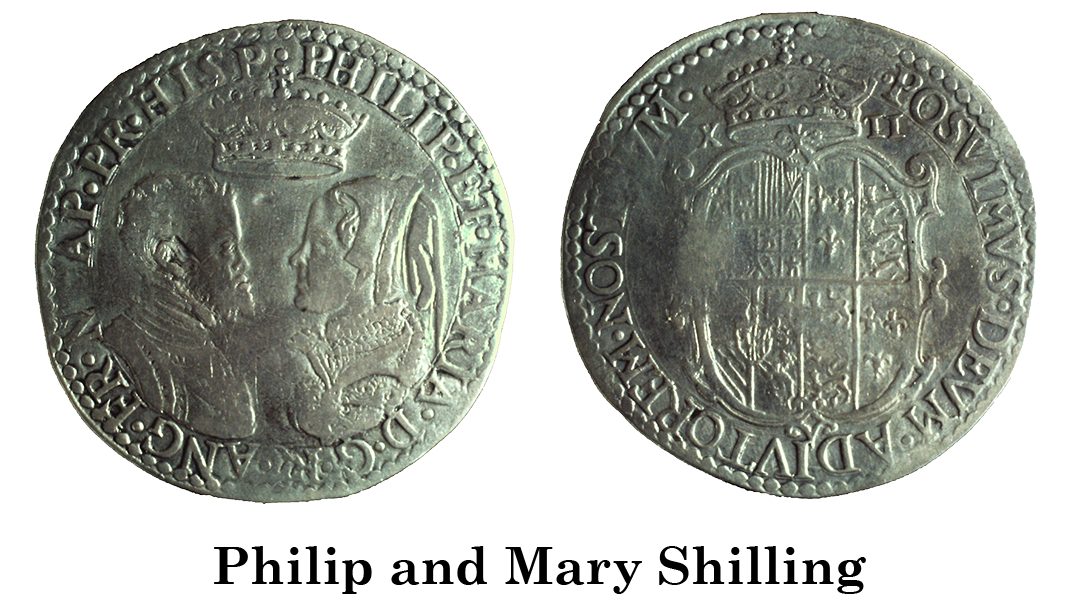
This damaged shilling of Philip and Mary helps us understand the difficulties of interpretation. On this coin, the head of Philip has received a blow with a chisel. Traditionally, the damage has been taken to be a sign of protest.
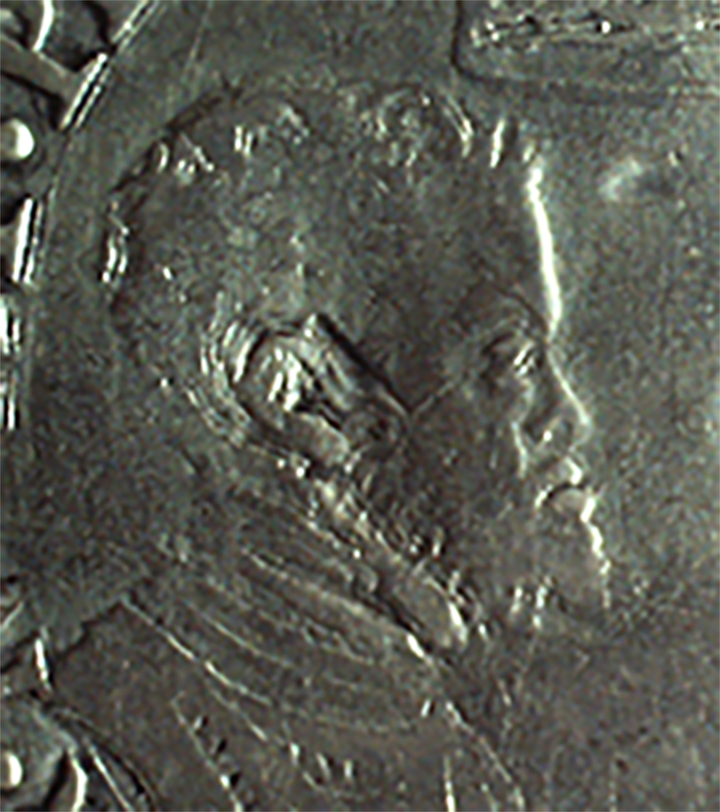
The chisel cut on the image of Philip could easily be seen as a protest against him. Yet, we will never know if the perpetrator was protesting the man, his religion, his ethnicity or the politics of the situation. Even if the damage was semiotically motivated, the details of the protest will elude us forever.
Other kinds of damage
When we turn to other ways to damage coins, the interpretation becomes even more uncertain. In each of the following cases, the number of known examples is small, and thus ritual activity can immediately be ruled out. Furthermore, it is even less plausible that something semiotic is in evidence. More mundane and practical reasons can explain the damage.
Test cuts of various kinds
Small numbers of coins appear with different kinds of test cuts. The most common are ancient plated forgeries with knife cuts to the rim (not to be confused with flan cracks, which are very different in appearance). The cut reveals the base metal under the plating.(Info)
These should simply be interpreted as coins that were checked for authenticity. Plated coins are almost always lighter in weight than genuine ones. Fine balances were fairly common objects in pre-Roman Britain, and people were probably weighing coins as a first step in revealing forgeries. The test cut to the rim would verify the cause of the light weight.(Info)
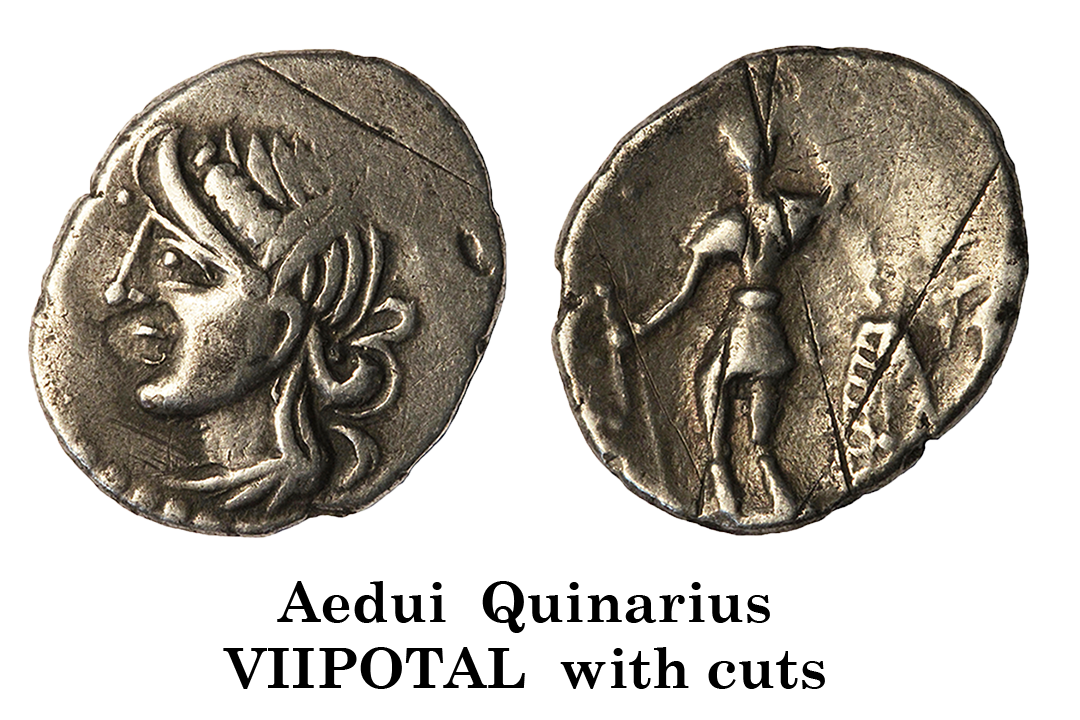
This Gaulish coin has several cuts across the obverse and reverse. Inspection with a stereomicroscope at 50X shows the depth of the cut varies and the lines aren't completely straight. It appears a sharp object was drawn across the surface, causing the varying depth as the graver skipped over the coin's relief. The cuts appear to be ancient and the coin is not a plated forgery. The vandal might have been testing the sharpness of a graver, rather than the coin itself.
On plated coins, this kind of damage is usually interpreted as a test of the coin's metal.(Info) Very rarely one sees a coin tested with a punch to reveal the base metal.(Info)
There's no reason to believe the damage on any coins with test cuts has been semiotically motivated.
Attempts to cut coins into pieces

This coin was reportedly found with the X cuts across the obverse. At first, it appears the coin was hit with a spade while still buried in the ground. Thwarted, the digger then rotated the spade and tried again, hoping to miss the buried object. However, inspection with a stereomicroscope reveals nothing of the sort has occurred – the coin was not buried when the damage was inflicted. The coin has received multiple blows with a chisel, instead.
The width of the chisel was about half the diameter of the coin, such that it would take two blows end-to-end to cut the coin in half.
In the photos below, the arrows show where two chisel blows have overlapped, but failed to meet up perfectly.
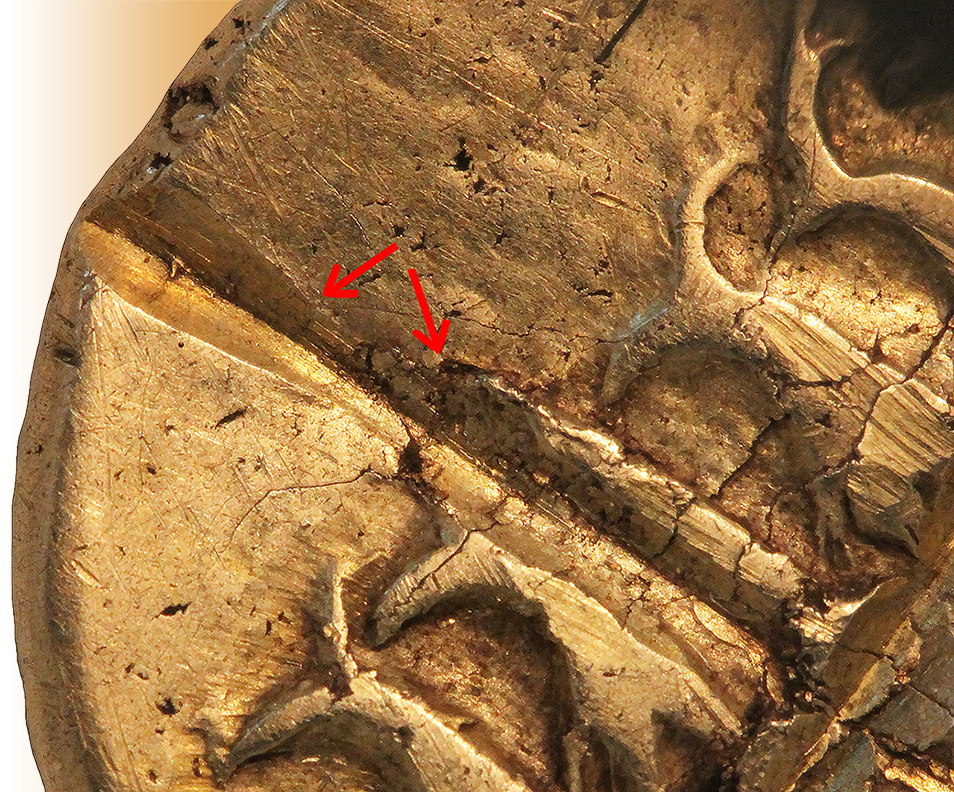
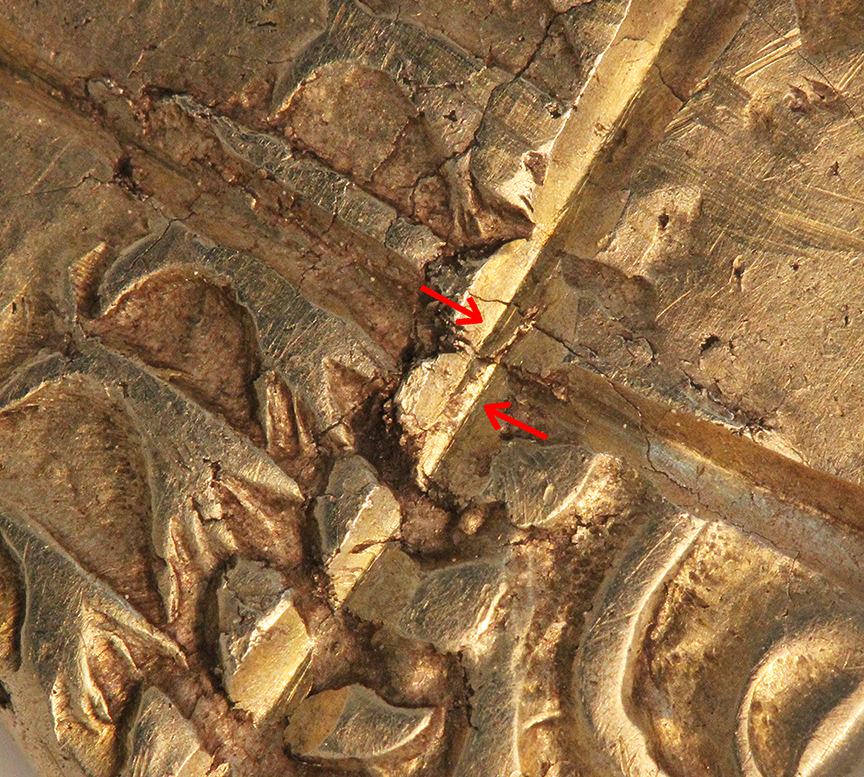
It's impossible to be certain about the chisel-wielder's intentions. The cuts aren't located properly to quarter the coin. The coin was probably chiseled as the first step to cutting it to pieces, but the work was never completed. The damage is unlikely to be semiotically-motivated. Further speculation at this point would be pointless.
Coins found with damaged objects
Very rarely is a coin found with an object, and it is the object that is damaged. Hoards of scrap metal can contain coins, but that is not the case with this coin. The coin and metal piece appeared in a trade list in May, 1992. They were reportedly found together in Dorset in 1992, but not as part of a hoard.
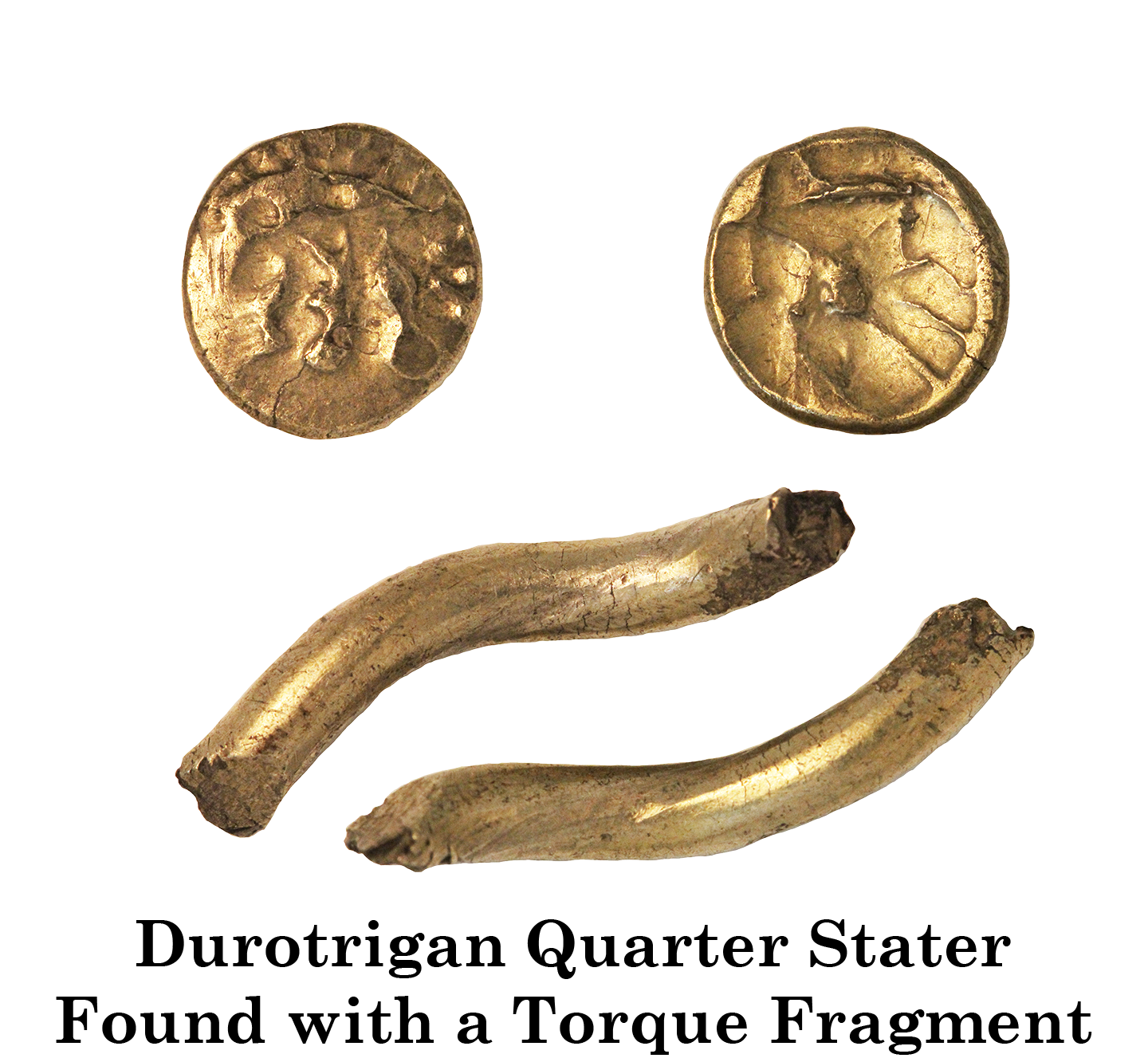
The coins is a Durotrigan quarter stater, V1225, of early Gallic War date. The metal piece is a broken strand of wire, about 4mm in diameter. It's been hammered almost round in section, and twisted. The fragment is almost certainly a piece of a broken-up torque.
People have always wondered if torques and coins could somehow be interchangeable: coins might have been melted down to make torques, and torques could be broken up to make coins.
Peter Northover analyzed the metal content of the coin and fragment with an Electron Microprobe to see if the torque could have been the source of the metal in the coin. The results are as follows:
| Coin | Torque | |
| Weight | 1.472 gms | 2.568 gms |
| Au | 23.98% | 23.92% |
| Ag | 56.22% | 47.40% |
| Cu | 19.41% | 28.52% |
| Fe | 0.01% | 0.02% |
| Co | 0.00% | 0.00% |
| Ni | 0.01% | 0.01% |
| Zn | 0.00% | 0.00% |
| As | 0.00% | 0.00% |
| Sb | 0.01% | 0.02% |
| Sn | 0.00% | 0.00% |
| Bi | 0.00% | 0.00% |
| Pb | 0.31% | 0.05% |
| S | 0.06% | 0.06% |
The coin and the torque fragment have different gold/silver/copper ratios and are not the same alloy (though the gold percentage is roughly the same). Theoretically, the gold from the torque could have been mixed with other metal to arrive at the coin's composition, but we have no way of knowing this actually happened. Thus the idea that the coin was made from the torque isn't proven. It's more likely that the two objects were just considered pieces of valuable metal. There is no reason to believe the damage to the torque was semiotically motivated.
Coins with holes
Very rarely, Celtic coins appear with holes through them. Most have been converted to pieces of jewelry and worn suspended around the neck.
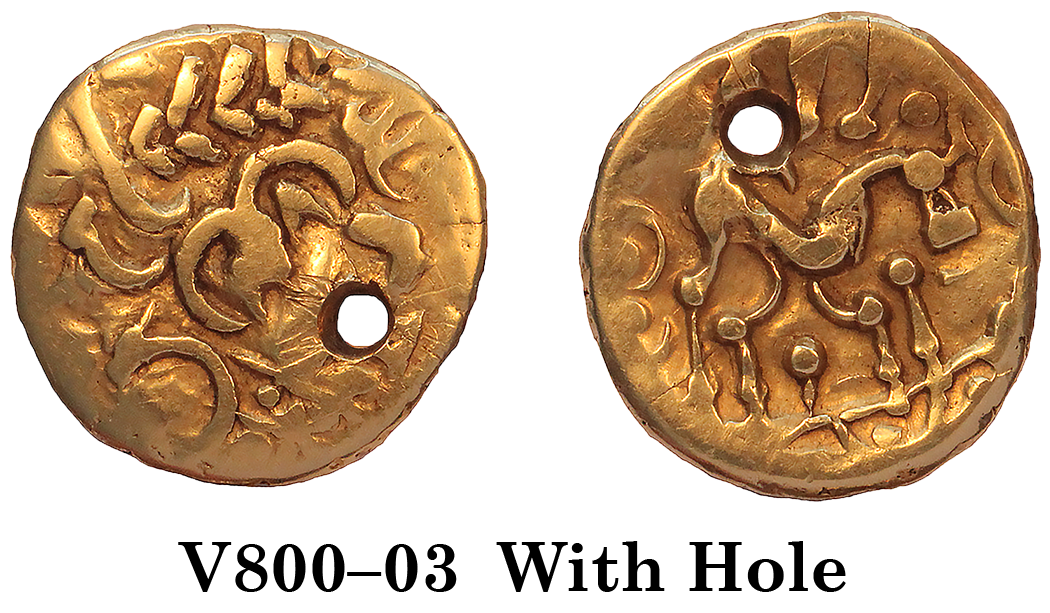
This example of a North East Coast stater of the Corieltauvi has been crudely holed in ancient times. The hole was started by drilling from both sides of the coin and roughly finished by gouging out the remaining metal. The coin shows considerable wear, as if it had been suspended around the neck for a long time. The wear is unusually smooth and appears identically on both the obverse and reverse – consistent with simultaneous rubbing between two soft surfaces. Rubbing the coin between the fingers (or some similar action) would account for this. The length of the suspension cord may have played a part.
It's useful to note that the hole has been placed such that the horse appears right-side-up when suspended. This suggests that the horse has something to do with the coin's use as a piece of jewelry (presumably a gift).
A similar coin in the British Museum has the hole placed such that the head of Apollo motif appears right-side-up when suspended. The orientation is the best clue we have to suggest that the obverse image may have been understood by the Britons.(Info)
A few other coins with holes have been reported, but not a sufficient number to suggest ritual activity.(Info)
That the holes appear to have been carefully oriented suggests something semiotic is going on here. Perhaps the message of the coin image was important to the wearer, who was making a statement by wearing the coin. The sort of thing involved might be an appeal to Epona for protection, but that tantalizing speculation cannot be proven.
Summary
In general, the idea that coins were ritually-damaged, much less ritually-killed is just an unsubstantiated speculation. The number of instances reported are too few to demonstrate any wide-spread ritual was practiced.
Some coins may have been damaged to somehow "send a message", but most are not. In the vast majority of cases, more mundane, practical reasons were the cause.
End
